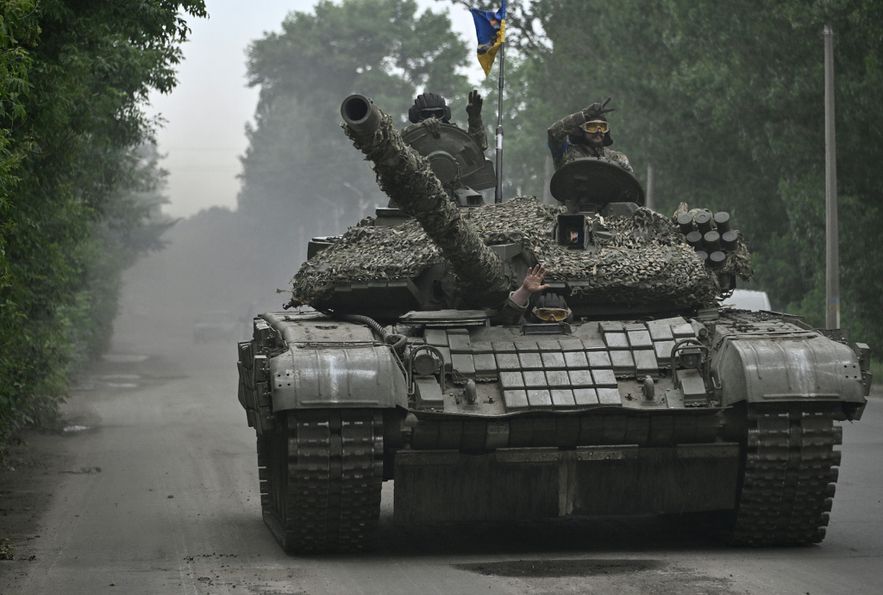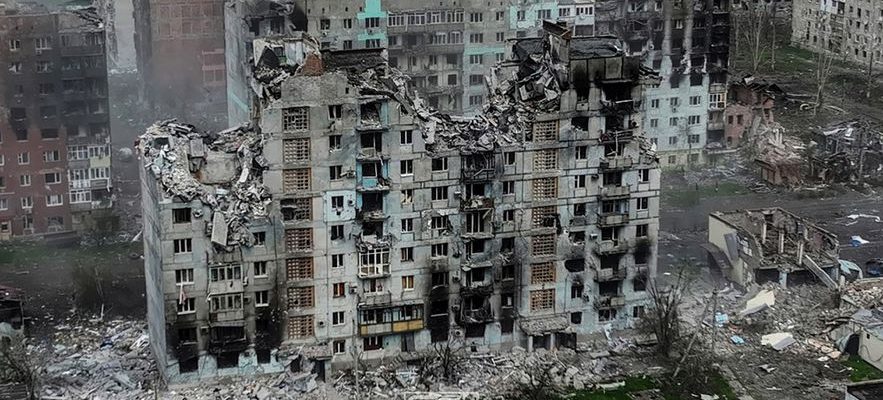A month after the start of the long-awaited Ukrainian counter-offensive, and on the 500th day of the war, what is the first assessment of the operations? “Last week was difficult on the front, but we are making progress. We are moving forward step by step,” summed up President Zelensky at the start of the week. “For the moment, the Ukrainians continue to test the Russian defenses at different places on the front”, points out General (2S) Michel Yakovleff, former vice-chief of staff of Shape, the supreme combined command for the operations of the ‘NATO. But, he warns, “time is now playing in favor of the Ukrainians”. At issue: the weakening of Putin’s regime, recently brought to light by Wagner’s rebellion. Interview.
L’Express: A month after the start of the Ukrainian counter-offensive, what is your initial assessment of the operations?
Michel Yakovleff: We see first of all that the Ukrainians have not yet succeeded in breaking through the Russian defense lines and that, at the same time, the Russian front has not collapsed. We can, however, note that the Ukrainians have not engaged all of their maneuvering mass: they therefore still potentially have reserves to progress. For the time being, they continue to test the Russian defenses at different places on the front.
The objective is to determine the sectors where it would be the easiest to break through, before pushing a big blow in the Russian depth. In other words: put the bayonet in the Russian device to see if there is a possible breach. In the ideal scenario, the Ukrainians would have to be able to reach the Sea of Azov, in order to cut the Russian force in the south of the country in two. This would place Putin’s forces in an extremely perilous situation.
Do the Ukrainians have the capacity to go that far?
I’m not sure of it. In any case, Ukrainian forces must be careful not to exhaust their reserves for marginal gains. It would be meaningless to embark on a “Russian-style” war, throwing all your forces into battle to gain only a few kilometers. After a while, if they can’t break through, it’s better to stop and save your reserves for later. It’s like a single-shot rifle: when you’re not sure of your shot, it’s better to keep the ammunition.
At this stage, the Ukrainian forces have managed to recapture approximately 160 km2. Can we speak of a modest progression?
It’s more than the Russians in recent months, and in a shorter period of time, but it’s still rather modest indeed. It is however too early to speak of failure, because the counter-offensive is not over. It will be a failure if the Ukrainians fail to break through. Afterwards, we cannot exclude that the forces of kyiv manage to dig a breach and rush into it in the coming weeks, even if I prefer to remain cautious at this stage.
We see that the Ukrainians are also continuing their efforts in the Bakhmout sector. Do they have a chance of taking over the city?
This seems to me within their reach, and without necessarily committing all their means. It would be necessary for that to succeed in encircling the city, to force the Russians to withdraw. It would be a very interesting possibility, because it would negate the last Russian victory. Therefore, even if the Ukrainians failed to break through Russian defenses elsewhere on the front line, it would deprive Putin of a victory speech. Indeed, it would be impossible for him to claim that his army succeeded in defeating the Ukrainian counter-offensive, if at the same time he lost control of this city that his forces had taken months to conquer. And that would be another blow to his already demoralized regime.
Undated photo released by a Ukrainian military news service on May 21, 2023 shows destroyed buildings in the Ukrainian city of Bakhmout
© / afp.com/Handout
Does the Ukrainian counter-offensive at least exhaust Russian resources?
The Russians do lose resources in these Ukrainian counterattacks, but the Ukrainians lose just as much leading them. Statistically, when you are in this phase of the attack, your losses balance those of the opposite. So I don’t really believe in the hypothesis that these attacks were intended to drain Russian resources.
Ukraine conducts its counter-offensive without real air cover. Is it a big handicap?
In theory yes, but in practice it is to qualify, because the density of the air defenses, on both sides, prevents the aircraft from flying in number anyway. The air force, in both camps, intervenes de facto relatively little, and not decisively. So even if the Ukrainians got the F-16s they want, it would have little impact. In reality, the Ukrainians especially need the ATACMS, these missiles with a range of 300 kilometers that the Americans are still considering giving them. F-16s could certainly help Ukraine destroy Russian battery positions, but ATACMS would be much more effective.
How could they change the situation?
They would make it possible to strike deep into Russian depth and could, therefore, considerably complicate their lives. Thanks to these missiles, the Ukrainians would be able to threaten, with great precision, many objectives: including the Kerch bridge, which connects Russia to Crimea, and constitutes a major logistical axis. Overall, the entire Russian device in Ukraine would be under the threat of Ukrainian fire. Concretely, this would force the Russians to store their stocks of ammunition and fuel even further away, to prevent them from being targeted. This would hinder their maneuvers and their responsiveness in the event of the start of a Ukrainian breakthrough: if Russian trucks are forced to travel 200 to 300 kilometers to transport their logistics, it necessarily takes longer.
What other materials would the Ukrainians need in priority?
In particular, they need breaching equipment against minefields. For example, minesweeper tanks, which are equipped with a flail hitting the ground in front of them to detonate mines. The problem is that there are very few left today in Western armies, whereas we had a few dozen at our disposal during the Cold War. The same goes for the bridging means, making it possible to cross watercourses. This could be very useful for the Ukrainians, for example to cross the Dnieper, but once again, our resources are very limited today in this area.
Ukrainian forces also need deep strike capabilities. Beyond the ATACMS, there are the GLSDBs which are glide bombs with a range of about 120 kilometers, that is to say more than the Himars that the Americans have already delivered to them. Moreover, the Ukrainians also need ammunition, in particular 155 mm shells, in order to be able to continue cannonading.
Are the mines, which were dropped en masse by the Russians, particularly devastating for the Ukrainians?
Ukrainians do have problems with Russian mines. In themselves, they do not necessarily destroy a large number of armored vehicles, but they cause them to waste time, concentrate them in one place, and expose them to enemy artillery fire. Concretely, when everyone is stuck behind the minesweeper, that’s when you take losses. From a defensive perspective, this is called upgrading a minefield. We don’t leave mines alone. They are there to delay the enemy forces and concentrate them in certain places that we can then hit.

A Ukrainian tank in the Donetsk region (east) on June 28, 2023
© / afp.com/Genya SAVILOV
Overall, are Russian forces more effective in defense than in offensive?
Yes. The Russians had many months to refine their defensive system, and it shows. As much as the Russian troops were relatively incompetent on the offensive, they manage to hold on in defensive mode. It should be remembered that the defender always has an advantage over the attacker: this is true in any war. And for now, the Russian defenses are strong enough to stop the Ukrainians.
Concretely, how are these defenses organised?
There are several lines of defense, which are made up of many obstacles: for example dragons’ teeth, these concrete cones used to slow down armored vehicles, but also trenches and mines. All of this device is enhanced, that is to say it is covered by artillery, infantry and anti-tank missiles. A series of support points, which could be described as resistance mauls, are also integrated into this device.
The defender’s objective is to let the attacker rush into the defensive system, then to destroy it from its bordering points of support. The purpose of the lines of defense is therefore to delay and channel the opponent, to make him vulnerable to your strikes. This is the basic principle of defense in depth. But the Russians had more than eight months to prepare the ground: their system is therefore necessarily difficult to cross.
What state is the Russian army in today?
For the moment, it manages to withstand the shock of the Ukrainian counter-offensive, but it remains in poor condition. And in my view, its greatest weakness today is the ongoing disintegration of Putin’s regime, which was best exemplified with Wagner’s rebellion. Today, the Russian army is a patchwork of motley forces from three different ministries, and 23 militias, the most visible of which was Wagner.
There are so many troops out of control in this system that the day Putin’s regime begins to seriously falter, everyone will quickly start defending their own interests. At that point, the Russian front could very well collapse, as it did in 1917. Moreover, it was Putin who recalled the events of 1917, during his address to the nation on June 24 . I think this is today the main threat for the Russian army. If the Ukrainians manage to break through, it could speed up the process. But if they can’t, they might as well wait for the ripe fruit to fall from the tree on its own.
So time is against Putin?
Absolutely. Putin thinks that time is on his side, because he has industrial power and a larger population than Ukraine, but in reality it is the opposite: for the simple reason that his regime is very weak and could end up collapsing on itself. When Prigozhin led his raid over 800 kilometers towards Moscow, there was hardly anyone to stop him. Wagner’s boss finally changed his mind and didn’t go through with it, but there are other sharks in the lagoon and they smelled blood. In truth, I think time is now on the side of the Ukrainians. Putin’s regime has entered a terminal phase, and I believe that the resolution of this war will require its collapse, sooner or later.
Should Ukraine expect strong announcements during the next NATO summit which opens in Vilnius on July 11?
NATO will convey three main messages during this summit: the first is to continue to support Ukraine over the long term. The second is the announcement of a multi-year support plan. And the third is to increase cooperation at the political level between NATO and Ukraine. NATO is therefore placing itself in the perspective of long-term support, and this is an important point, even if it is to be regretted that the Alliance is not more committed alongside Ukraine, in particular in the look at the tectonic movements that seem to be working the Russian regime. Moreover, the Ukrainians clearly understand that they are not going to become members of NATO at the Vilnius summit, since that would imply an entry into the war of the members of the Alliance against Russia.
